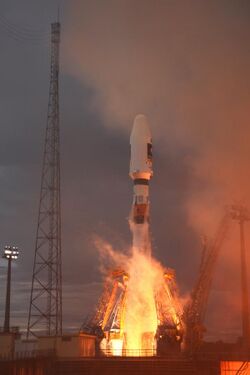Rocket launch
Topic: Engineering
 From HandWiki - Reading time: 3 min
From HandWiki - Reading time: 3 min
A rocket launch is the takeoff phase of the flight of a rocket. Launches for orbital spaceflights, or launches into interplanetary space, are usually from a fixed location on the ground, but may also be from a floating platform or from an airplane.
Launches of suborbital flights (including missile launches), can also be from:
- a missile silo
- a mobile launcher vehicle
- a submarine
- air launch:
- from a plane (e.g. Scaled Composites SpaceShipOne, Pegasus Rocket, X-15)
- from a balloon (Rockoon, da Vinci Project (under development), Bloostar (Also under development)
- a surface ship (Aegis Ballistic Missile Defense System) or ocean-based platform (Sea Launch)
- an inclined rail (e.g. rocket sled launch)
Launches not into space can also be from:
- the shoulder
A skyrocket is launched from some stand.
"Rocket launch technologies" generally refers to the entire set of systems needed to successfully launch a vehicle, not just the vehicle itself, but also the firing control systems, ground control station, launch pad, and tracking stations needed for a successful launch and/or recovery.
Commercial launches
Commercial launch service providers include:
- Antrix Corporation (PSLV/GSLV)
- Arianespace (Ariane 5/Soyuz-2/Vega)
- China Aerospace Science and Technology Corporation (Long March)
- Eurockot Launch Services (Rockot)
- International Launch Services (Proton-M)
- ISC Kosmotras (Dnepr)
- Land Launch (Zenit-2SLB/Zenit-3SLB)
- Mitsubishi Heavy Industries (H-IIA/H-IIB)
- Northrop Grumman Innovation Systems (Antares/Minotaur/Pegasus)
- Sea Launch (Zenit-3SL)
- SpaceX (Falcon 9/Falcon Heavy)
- Starsem (Soyuz-FG/Soyuz-2)
- United Launch Alliance (Atlas V/Delta IV)
Launch vehicles
If a rocket is launched to deliver a payload from a planetary surface into space it is called a launch vehicle.
There are several broad categories that launch vehicles fall under, including:
- Expendable launch system
- Reusable launch system
- Single stage to orbit
- Two stage to orbit
- Three stage to orbit
For the launch vehicles currently in use for human spaceflight, see that article. There were over 70 orbital launches in 2010.
Orbital launches
Orbital launch vehicles commonly take off vertically, and then begin to progressively lean over, usually following a gravity turn trajectory.
Once above the majority of the atmosphere, the vehicle then angles the rocket jet, pointing it largely horizontally but somewhat downwards, which permits the vehicle to gain and then maintain altitude while increasing horizontal speed. As the speed grows, the vehicle will become more and more horizontal until at orbital speed, the engine will cut off.
All current vehicles stage, that is, jettison hardware on the way to orbit. Although vehicles have been proposed which would be able to reach orbit without staging, none have ever been constructed, and, if powered only by rockets, the exponentially increasing fuel requirements of such a vehicle would make its useful payload tiny or nonexistent. Most current and historical launch vehicles "expend" their jettisoned hardware, typically by allowing it to crash into the ocean, but some have recovered and reused jettisoned hardware, either by parachute or by propulsive landing.
When launching a spacecraft to orbit, a "dogleg" is a guided, powered turn during ascent phase that causes a rocket's flight path to deviate from a "straight" path. A dogleg is necessary if the desired launch azimuth, to reach a desired orbital inclination, would take the ground track over land (or over a populated area, e.g. Russia usually does launch over land, but over unpopulated areas), or if the rocket is trying to reach an orbital plane that does not reach the latitude of the launch site. Doglegs are undesirable due to extra onboard fuel required, causing heavier load, and a reduction of vehicle performance.
See also
- Launch mechanisms
- Gravity drag
- Non-rocket spacelaunch
- List of rockets
- Orbital spaceflight
- Sub-orbital spaceflight
- Spaceport
- List of rocket launch sites
- Launch status check
- List of space launch system designs
External links
fi:Kantoraketti
 KSF
KSF

